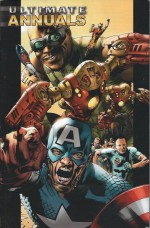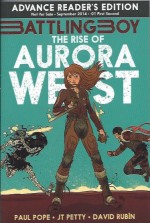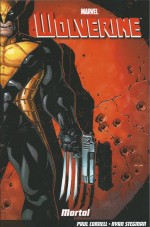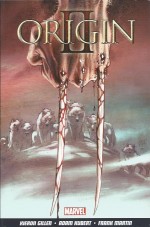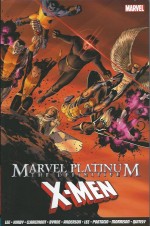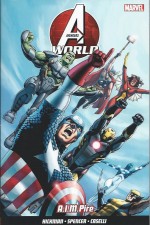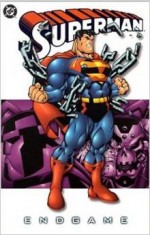
By Jeph Loeb, Mark Schultz, Joe Kelly, Mark Millar, Stuart Immonen, Butch Guice, Ed McGuiness, Doug Mahnke, German Garcia, & various (DC Comics)
ISBN: 978-1-56389-701-6
The Man of Tomorrow has proven to be all things to most people over more than three quarters of a century of drama and adventure, with Jerry Siegel & Joe Shuster’s iconic Superman now practically unrecognisable to most fans after the latest radical shake-up. Nevertheless, every refit and reboot has resulted in appalled fans and new devotees in pretty much equal proportion, so perhaps the Action Ace’s greatest ability is the power to survive change…
Although largely out of favour these days as all the myriad decades of accrued mythology are inexorably re-assimilated into an overarching, all-inclusive multi-media dominant, film-favoured continuity, the grittily stripped-down, post-Crisis on Infinite Earths Man of Steel (as re-imagined by John Byrne and superbly built upon by a succession of immensely talented comics craftsmen) resulted in some stunning high points.
As soon as the Byrne restart had demolished much of the mythology and iconography which had grown up around the “Strange Visitor from Another World†over fifty glorious years, successive creators began spending a great deal of time and ingenuity putting much of it back, albeit in terms more accessible to a cynical and well-informed audience far more sophisticated than their grandparents ever were.
Even so, by the mid-1990’s Byrne’s baby was beginning to look a little tired and the sales kick generated by the Death of and Return of Superman was fading fast, so the decision was made to give the big guy a bit of a tweak for the fast-approaching new millennium: bringing in new writers and artists and gradually moving the stories into more bombastic, hyper-powered territory.
The fresh tone was augmented by a new sequence and style of trade paperback editions and this second (not strictly chronological) collection gathers material from Superman Y2K, Superman #154, Superman: Man of Steel # 98, Action Comics #763 and The Adventures of Superman #576, covering December 1999-March 2000.
The tension-wracked doom days begin with the Superman Y2K one-shot special, crafted by scripter Joe Casey and artists Butch Guice, Kevin Conrad, Mark Prompst & Richard Bonk.
‘The End’ traces the history of the Luthor family in Metropolis from the first settlers in America to the present day when Last Son Lex practically owns the entire place as a counterpoint to the ongoing action…
With the end of the Holidays fast approaching, staunch traditionalist Clark Kent is facing a shocking crisis: new wife Lois and his own mother want to elbow the sacrosanct seasonal tradition of a quiet New Year’s on the Smallville farm for a (non-catering) vacation in the Big City…
Bowing to the inevitable, the Husband of Steel ferries the family to a Metropolis gripped with terror that all the computers in the world will imminently expire prompting the end of civilisation as the millennium closes (kids – this was genuine abiding fear at the time: for more information check here)…
When the countdown concludes everybody’s fears are completely justified as an alien entity overwhelms the world’s computer systems, triggering a wave of destruction affecting every electronic device on Earth…
Alien digital dictator Brainac 2.5 has upgraded himself since his last attack but his hatred for Lex Luthor remains unchanged. Whilst every hero on Earth battles panic, riots and failing technologies, Superman and Green Lantern are busy trying to catch all the nuclear missiles launched during the terrifying induced glitch, the computer dictator is trying his hardest to murder Lex and his baby daughter Lena.
As part of his scheme Brainiac 2.5 has also enslaved Earth’s many robotic and android entities such as Red Tornado, Hourman and the Metal Men, but the AI invader is blithely unaware that he too is being used…
With the world – and especially Metropolis – crashing into ruin the secret invader makes its move: from the far distant future the merciless Brainac 13 program has been attempting to overwrite its ancient ancestor and take over Earth centuries before it was even devised…
The tension intensifies in ‘Whatever Happened to the City of Tomorrow?’ by Jeph Loeb, Ed McGuiness & Cam Smith (Superman volume 2 #154, March 2000) as the colossal chronologically-displaced construct begins reformatting the world; converting matter into materials and designs analogous to its own time. Unfortunately that’s very bad news for the billions of human beings inside buildings, vehicles and vessels undergoing those transformations…
Even Luthor is helpless, locked out of his own corporate tower as “his†city falls apart and the Man of Steel is occupied battling Brainiac 13 and upgraded cyborg assassin Metallo. Assistance arrives in most unwelcome form as little Lena begins offering technical advice. The toddler has been possessed by presumed-destroyed Brainiac 2.5: simultaneously becoming hostage and bolt-hole for the outmoded and nigh-obsolete alien menace…
With the aid of the Metal Men Superman finally defeats Metallo and confers with Lois and Jimmy Olsen. The games-mad lad theorises that the transforming city is starting to resemble a gigantic motherboard…
As elsewhere Jonathan and Martha Kent are trapped aboard a subway train programmed to deliver organic units to a slave-indoctrination station, the Man of Tomorrow attempts to dislodge the computerising city’s main power cable. When Brainiac 13 tries to digitise and absorb the annoying Kryptonian it accidentally reverts the hero to a previous incarnation: the electrical form of Superman Blue…
The hostile planetary hacking continues in ‘AnarchY2Knowledge’ (by Mark Millar, Stuart Immonen & José Marzan, Jr. from The Adventures of Superman #576) wherein the Man of Energy hopelessly tackles Brainiac 13 and tries to quell the rising body count of helpless humans, whilst far below Luthor and Lena 2.5 battle through the overwritten bowels of the LexCorp Tower past marauding B13 creations to a stolen secret weapon…
The possessed tot shares a direct link with all Brainiacs’ core programming and has discovered a possible backdoor that could enable them to destroy the all-pervasive program from the future.
Their progress is greatly facilitated after Luthor’s lethally devoted bodyguards Hope and Mercy finally locate them. As their preparations proceed the villains opt to rescue Superman, incidentally restoring the Action Ace to his flesh and blood state. To save Metropolis for his family, the evil billionaire will even work with his most hated enemy…
Superman: Man of Steel # 98 continued the epic in ‘Thirty Minutes to Oblivion’ by Mark Schultz, Doug Mahnke & Tom Nguyen as the senior Kents face conversion into B13 drones but enjoy a last moment rescue by the Man of Steel and his sometime foe The Eradicator.
After a lengthy period of self-impose banishment in deep space (for which see Superman: Exile) the Man of Tomorrow returned to Earth carrying an incredibly powerful Kryptonian artefact which had survived the destruction of the planet. The Eradicator could reshape matter and was programmed to preserve, or indeed, resurrect and restore the heritage and influence of the lost civilisation at all costs.
After a number of close calls Superman realised the device was too dangerous to leave loose so he buried it in an Antarctic crevasse and foolishly assumed that ended the affair.
Such was not the case and the miracle machine returned many times, always attempting to remake Earth into a New Krypton.
When Superman died it created a new body and sought to carry on Kal-El‘s legacy… Eventually it failed once more and fell into the hands of dying scientist David Connor who merged with the manufactured body to produce a phenomenally powerful – if morally and emotionally conflicted – new hero…
Superman’s understandable anxiety is soon assuaged as Eradicator assures him he is there to help and proves it by pointing out a weakness in the B13 tech assimilation. The transmode programs have as yet been unable to infect Kryptonian systems such as those in the hero’s Fortress of Solitude, but the base has now become the invader’s primary target.
If the program masters Kryptonian systems it will be utterly unstoppable…
After finishing off Metallo and the Metal Men, Eradicator and Superman head to the Fortress whilst in his factory inventor John Henry Irons (AKA Steel, part-time hero and hi-tech armourer to the City police force) and his niece Natasha find their own temporary answer to the threat of the constantly encroaching and bloodthirsty B13 drones…
Deep below LexCorp, Luthor and Lena 2.5 are working towards similar goals with the same insights whilst planning to betray each other later.
Admitting that the Brainiac core systems can’t even see Kryptonian tech, the baby bodysnatcher advises Lex to modify the robotic warsuit stolen from Superman and use it against the apparently omnipotent digital invader.
In the Antarctic however events have moved to a crisis point as the Fortress – transformed by echoes of the original Eradicator – has reconstructed itself into a colossal warrior and attempts to co-opt the predatory B13 programs to facilitate its own primary mission of recreating Krypton.
To counter this threat David Connor pays an intolerable price…
The epic comes to a startling conclusion in‘Sacrifice for Tomorrow’ (Joe Kelly, German Garcia, Kano & Marlo Alquiza from Action Comics #763) as Superman heads back to Metropolis armed with the knowledge of B13’s Achilles heel and his swiftly repurposed Kryptonian butler Kelex…
Attacking the monstrous computer tyrant with a wave of robotic heroes, the Man of Tomorrow is again repulsed and goes looking for Luthor’s aid. However, despite Lex’s resolve to work with the Man of Steel to defeat Brainiac, the billionaire cannot resist turning the warsuit on its previous owner – a character flaw Superman was counting on – creating an opportunity to hijack the Kryptonian armour’s systems to power a forced crash in Brainiac 13…
The blockbuster battle ends as the world is rapidly reconverted to its original state, but for some inexplicable reason the remission halts outside Metropolis. The city remains an incomprehensible artefact of a far future with Luthor in control, frantically patenting thousands of incredible technological advances.
There is no sign of baby Lena and the master of Metropolis refuses to hear her name mentioned…
To Be Continued…
With covers by Guice, McGuiness & Cam Smith, Immonen & Marzan, Mahnke & John Dell, German Garcia & Jaime Mendoza, this staggering compilation introduced a whole new world – and a wealth of fresh problems – for the venerable, wide-ranging cast to cope with and further built upon the scintillating re-casting of the greatest of all superheroes. Lovers of the genre cannot help but respond to sheer scale, spectacle and compelling soap opera melodrama of these tales which will still delight all fans of pure untrammelled Fights ‘n’ Tights fiction.
© 2000, 2001 DC Comics. All Rights Reserved.

